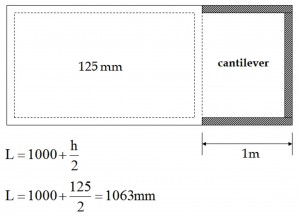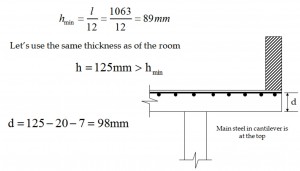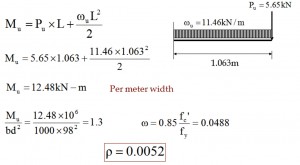Analysis and Design of Slabs “One Way”
Slabs
- In reinforced concrete construction, slabs are used to flat, useful surfaces..
- A reinforced slab is a broad, flat plate, usually horizontal, with top and bottom surfaces parallel or nearly so. Analysis and Design of Slabs
- It may be supported by reinforced concrete beams (and is usually cast monolithically with such beams), by masonry or by reinforced concrete walls, by steel structural members, directly by columns, or continuously by ground.
One-Way Slab
“The slab which resists the entire/major part of applied load by bending only in one direction”
- If slab is supported on all four sides and R = (Shorter side / Longer side) < 0.5 it behaves as one-way slab. Analysis and Design of Slabs
-
Slabs having supports on less than four sides can be designed as one-way.
-
Two edge supported slab is always one-way.
-
Cantilever slab is always one-way.
- Main steel is only provided parallel to span
- One-way slab is designed as singly reinforced rectangular section.
- h(min) for the slab is different compared with the beams.


L = Effective Span
Lesser of the following:
L= Ln + h/2 + h/2
= Ln + h
h = depth of slab and
L = c/c distance between supports.
Examples of One-Way Slab
- Shades in the roofing system (cantilever)
- Slab of stairs
- Cantilever retaining walls
- Footings Analysis and Design of Slabs

Bar Spacing Cover For Slabs
- 3 x h (local practice is 2 x h)
- 450 mm (local practice is 300 mm)
- (158300/fy) -2.5Cc
- 12600/fy
Cc = Clear Cover
Analysis and Design of Slabs
Distribution, Temperature & Shrinkage Steel for Slabs (ACI-318-7.12)
- Shrinkage and temperature reinforcement is required at right angle to main reinforcement to minimize cracking and to tie the structure together to ensure its acting as assumed in design
- Top and bottom reinforcements are both effective in controlling the cracks
s(max) shall be lesser of following Analysis and Design of Slabs
- 5 x h (field practice is 2 x h)
- 450 mm (field practice is 2 x h)
Minimum Steel For Slabs
Same as the distribution steel Analysis and Design of Slabs
Design Procedure for One-Way Slab
- Check whether the slab is one-way or two-way.
- Calculate hmin and round it to higher 10mm multiple.
i.Not less than 110 mm for rooms
ii.Not less than 75 mm for sunshades. - Calculate dead load acting on the slab.
Dead Load = Load per unit area x 1m width. - Calculate live load acting on the slab.
Live load = Load per unit area x 1m width. - Calculate total factored load per unit strip (kN/m)
- Calculate the moments either directly (simply supported) or by using coefficient for continuous slabs
- Calculate effective depth. Analysis and Design of Slabs
d = h – (20 + (½)db)
db = 10, 13, 15 generally used - Check that d ≥ dmin
- Calculate As required for 1m width
- Calculate minimum/distribution/temperature & shrinkage steel
- Select diameter and spacing for main steel Analysis and Design of Slabs
- Check the spacing for max. and min. spacing smin ≈ 90mm
if spacing is less than minimum increase the diameter of bar -
For continuous slabs, curtail or bent up the +ve steel. For -ve steel see how much steel is already available. Provide remaining amount of steel.
-
Calculate the amount of distribution steel. Decide its dia. & spacing like main steel.
-
Check the slab for shear.
ΦvVc ≥ Vu Analysis and Design of Slabs -
Carry out detailing and show results on the drawings
-
Prepare bar bending schedule, if required
Approximate Steel for Estimate
Approximate amount of steel in slab
= 0.07 kg/mm/m2
If slab thickness = 100 mm
steel = 0.07 x 100 = 7kg /m2
Example
Design a cantilever projecting out from a room slab extending 1.0m and to be used as balcony (LL = 300 kg/m2). A brick wall of 250 mm thickness including plaster of 1.0m height is provided at the end of cantilever fc’ = 17.25 MPa, fy = 300 MPa, Slab thickness of room = 125 mm. Slab bottom steel in the direction of cantilever is # 13 @ 190 mm c/c. Analysis and Design of Slabs
Solution

Slab Load
Self Weight of Slab = (125/1000)*2400 = 300kg/m2
75 mm brick ballast/ screed = (75/1000)*1800 = 135kg/m2
60 mm floor finishes = (60/1000)*2300 = 138kg/m2
Total dead load = 300+135+138 = 573kg/m2
Live Load = 300kg/m2 Analysis and Design of Slabs
Factored Load = (1.2×573+1.6×300)x9.81/1000
= 11.46 KN/m2 = 11.46KN/m for a unit strip
P = 1.2x(0.25x1x1)x1930x9.81/1000
P = 5.65 KN Analysis and Design of Slabs

Remaining steel required at the top = 510-342 168mm2 (#10@400 c/c)
use #10 @ 380mm c/c
Distribution steel Analysis and Design of Slabs
=0.002x1000x125=250mm2 use # 10 @ 280mm c/c Analysis and Design of Slabs

unable to down load files
Get MEMbership then u will b able to download
http://civilengineerspk.com/membership/
very fine!
Thanks
i am civil engineer…i want to be member of Civil Engineer P K, so that i can get the latest information about civil engg.
You can get the latest information by subscribing to our posts. you can do that by entering your email in the box iunder follow blog via email on a widget at right side of civilengineerspk.com. If you want to be our member apply trough http://civilengineerspk.com/membership/
HOW YOU TAKE WL^2/2 FOR MOMENT WHAT IS THE ACI REQUIREMENT
Nice clear my doubts
Thanks
Im not an Engneer but likes Designs from an Engneers….
ok
what is the prospect of a job in civil engineering field
Requesting for information on design of slabs, timber, retaining structures and so forth
There are plenty of books available on our site related to structural design of all these things …. You can download them by becoming our member
Thanks
Best information___Gurme
Thanks
ACI requirement of contilaver beam moments and shear??
ull have to see the code
great
thanks
sir me is ka mamber ban na chahta hu to aap mujhe full information dene ka kast kre.
thnx
Rahul panwar
civil
How will you send the membership Fee ?
can you show how to design the two way slab of slab beam… thank you
two way slab design example is there
i want to know a lot from this..
u can
sure
i want design of complete design of conical water tank, caliculation of crack width also.
sir men new member bna hun kea as file ko pdf mn download nhi kr skty?
use any pdf software and click on ctrl+p then save it in pdf
Is there any computer application and turoria for design like orion18, stapro, prokon etc i really want to know it and i need someone to teach me. thanks.
We will try to upload them
so amazing
Thanks
how to do the bending moment calculation for multipurpose wall of one way roof slab??